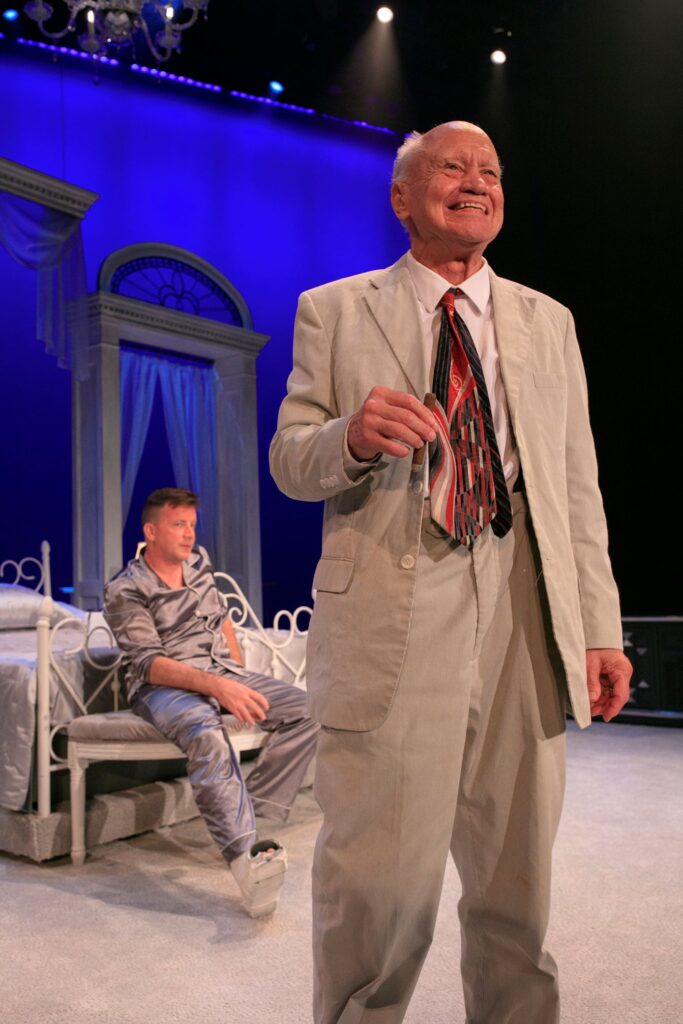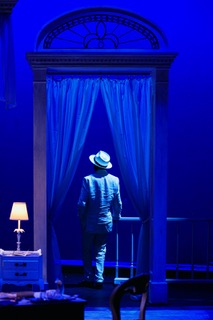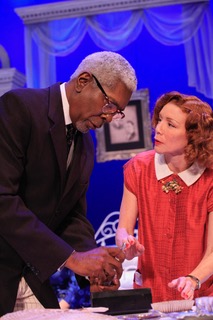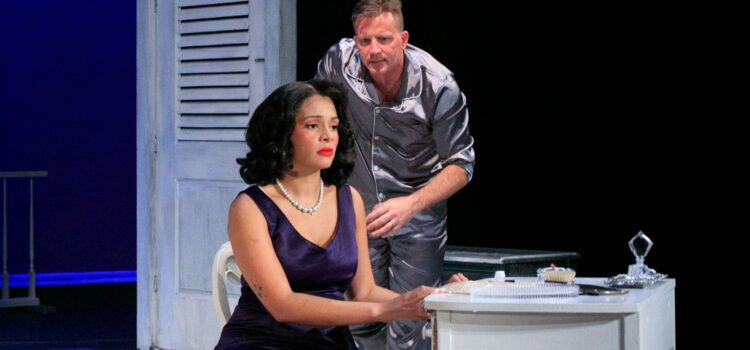By Lynn Venhaus
Avarice, malice and mendacity. Those words that Tennessee Williams used so eloquently to imply grown-ups behaving badly in “Cat on a Hot Tin Roof” demonstrate his brilliant command of the English language. His way with words, referred to as “poetic realism,” is always the most enduring part of his staged plays.
“Living with someone you love can be lonelier than living entirely alone if the one you love doesn’t love you,” says Margaret, aka Maggie the “Cat.”
And thus, Williams struck an abundant gold vein with his reflections on loss and longing, and how we cling to illusions to survive.
In a delectable story of big drama, big money and big lies, Williams has tightly woven a web of deceit, a Southern Gothic excursion into an American dysfunctional family, 1950s style.
At the plantation home of cotton tycoon Big Daddy (Peter Mayer), the Pollitt family is gathered for his 65th birthday celebration. He and his wife, Big Mama (Kari Ely), think he’s free of cancer but the real diagnosis is dire. Things unravel from there, with secrets and revelations in rapid succession over the course of an evening.
The mood is a seething, simmering stew of sexual desire, spurned affection, power trips, greed, toxic relationships and lies they tell each other.
One of Williams’ most popular works, “Cat on a Hot Tin Roof” won the Pulitzer Prize for Drama in 1955 and has received multiple revivals on Broadway over the years, including a 2013 staging with Scarlett Johansson as Maggie, and a 1990 version with Kathleen Turner.
Times change, rendering some of his subjects quaint and old-fashioned, but his characters always make a lasting impression even when the social mores he highlights are no longer as consequential or controversial. With his unmistakable vivid writing, he captures a specific time and place like few have.
Williams turned his short story, “Three Players of a Summer Game,” into this classic gem, which supposedly was his personal favorite. The play was adapted into a 1958 film starring Elizabeth Taylor and Paul Newman that earned six Oscar nominations including Best Picture. Granted, they cast a big shadow.

In a unique approach by director Michael Wilson, the narrative unfolds as a deliberately theatrical setting.
He has created a prologue where local treasure J. Samuel Davis appears in the audience as “The Writer,” telling of a young Tom “Tennessee” Williams’ early years working at the International Shoe Company in St. Louis and taking the ‘stairs to the roof’ (the name of his first play) to write his short stories.
The ensemble, dressed in black as stagehands, brings the set pieces on stage, and the play begins as they return as the troubled Pollitts.
Not that I know this for certain, but Wilson appeared to pay homage to the way Williams worked with his longtime director-collaborator Elia Kazan, in what they described as “plastic theatre,” in which they heightened awareness of events to open the audience to more abstract ideas.
James Wolk’s evocative set seems dream-like on the fringes, and nightmarish in the claustrophobic bedroom. Williams did allude to ghosts, and people who lived there before – as evident in a hanging portrait. Lighting designer Matt McCarthy adds to the ethereal mood.
The epochal Maggie is a smart, scrappy, stunningly beautiful debutante who grew up poor and married into a family of money. She has been hardened by the in-laws’ power-grabbing chess games, but she has learned to swim in a sea of sharks and will fight for what she thinks she deserves.
Her handsome all-American football hero husband Brick has decayed into a numb alcoholic who doesn’t care about anyone or anything.
Reeling from his best friend Skipper’s suicide, Brick is consumed by despair, regrets and rumors. He appears repulsed by his wife, which seems to aggravate her desire for attention. His busybody family knows every detail of the childless couple’s personal life – or think they do.

In a long scene that establishes their marital discord, Maggie prattles on, trying to engage her distant husband in conversation, but we can tell this is going to be a fruitless attempt. Resembling a young Natalie Wood (who starred in Williams’ film adaptation “This Property Is Condemned), actress Kiah McKirnan rushed through her opening lines and was difficult to understand.
However, she gets more forceful in acts two and three as tension mounts, and she needs to make her moves to secure her future.
Wearing the provocative iconic white satin slip recreated by costume designer Teresa Doggett, and moving gracefully, McKirnan appears to be the archetypal Maggie.
Slaten’s Brick doesn’t say much or move like a former athlete, but with a broken ankle and one crutch, he capably navigates the bed-sitting room, his hobbled body betraying him, and his pain palpable.
His outbursts are well-timed for maximum impact. This is a difficult role because of calibrating external and internal conflicts, and while Slaten doesn’t look like the stereotypical golden boy turned disappointment, he delivers the intensity.
Once upon a time, the couple must have been like the idealized bride and groom figurines on top of a wedding cake. But those days are long gone – and they both realize it, which tinges this play with sadness.
When Mayer arrives on stage as the bombastic Big Daddy, the show kicks into high gear. He throws his whole body into this role with impressive gusto. The interactions between the blustery braggart and his favorite son are the best in this production, and his profane rants against family members are welcome comic relief.
Surprisingly, he has tender advice for Brick: “One thing you can grow on a big place like this more important than cotton—is tolerance—I have grown it.” There appears to be real affection between the two.

Mayer is matched in intensity by Kari Ely as Big Mama, adding more emotional depth than the role is written. It’s a pleasure to see such local legends play off each other on stage – as they are married in real life.
Ely, who has been unforgettable as tough women Martha in “Who’s Afraid of Virginia Woolf?”, Regina in “The Little Foxes,” and Violet in “August: Osage County,” all at the St. Louis Actors’ Studio, makes this role her own, bringing out the heartbreak and strength of a character that had been easily dismissed before. Their performances are the chef’s kiss of this production, and set the rhythm in motion.
Eric Dean White, whose consistent professionalism makes him a terrific addition to any local stage, is superb as the calculating, scheming Gooper, a slick lawyer who tag teams with his devious wife Mae, aka “Sister Woman,” to block out his brother Brick and Maggie from inheriting Big Daddy’s massive estate. His delivery is smooth and shrewd.
Roxanne Wellington nails the vindictive and insincere opportunist Mae, conveying an ugly sanctimonious streak. She must get this crack in: “He never carried a thing in his life but a football and a highball,” adding a fake laugh.
They are the indulgent parents of the notorious “no-neck monsters” that get on Maggie’s last nerve. Youngsters Kate Koppel, Tatum Wilson, and Cooper Scheessele are lively in their portrayals of three of their five children (and one is on the way).
Maggie displays some humor too, retorting: “Dixie, Trixie, Buster, Sonny, Polly! —sounds like four dogs and a parrot … animal acts at a circus.”

Davis returns as a doctor and a minister in supporting roles.
Wilson, who is reverent regarding Williams, directed the acclaimed Cicely Tyson-starring “The Trip to Bountiful” on Broadway in 2013, and the subsequent film a year later. He benefits from a potent ensemble who understands the defining message is that people are better together than apart.
Unfortunately, in a play that talks so much about communication, the Grandel’s sound system was a hindrance on the left side, so I recommend sitting right or center. None of the performers are wearing microphones in that small thrust stage space. Sitting on the left side, in the seventh row, on opening night, I had difficulty hearing, especially because the cast is often staged in profile.
The sound issues have happened before at The Grandel, as a production of “Kinky Boots” last summer by Tesseract Theatre Company, was marred. This is always a shame because obviously much attention went into the production details. Perhaps sound designer Phillip Evans can crack the code.
In a conscientious retelling of one of Williams’ best works that emphasizes his compassion for misfits and fragile souls, we are reminded of his impact on storytelling and our broader view of the world.
In their ninth year, the Tennessee Williams Festival St. Louis furthers their commitment to celebrate the artistry and influence of the playwright who called St. Louis home during his formative years.

The Tennessee Williams Festival St. Louis presents “Cat on a Hot Tin Roof” from Aug. 8 to Aug. 18 at The Grandel Theatre in Grand Center, with performances at 7 p.m. Thursday through Saturday, and Sunday matinees at 3 p.m. Tickets are on sale through Metrotix. Additional information and Festival event details can be found at twstl.org.
Post-show commentary will be conducted by Resident Scholar, Tom Mitchell, on Sunday, Aug. 12 and Thursday Aug.15.
Parking: Guest parking is available at the Fox Garage for $5 (3637 Washington Ave, St. Louis, MO 63108). Please, tell the attendant you are with the Tennessee Williams Festival to receive a discount.

Lynn (Zipfel) Venhaus has had a continuous byline in St. Louis metro region publications since 1978. She writes features and news for Belleville News-Democrat and contributes to St. Louis magazine and other publications.
She is a Rotten Tomatoes-approved film critic, currently reviews films for Webster-Kirkwood Times and KTRS Radio, covers entertainment for PopLifeSTL.com and co-hosts podcast PopLifeSTL.com…Presents.
She is a member of Critics Choice Association, where she serves on the women’s and marketing committees; Alliance of Women Film Journalists; and on the board of the St. Louis Film Critics Association. She is a founding and board member of the St. Louis Theater Circle.
She is retired from teaching journalism/media as an adjunct college instructor.

